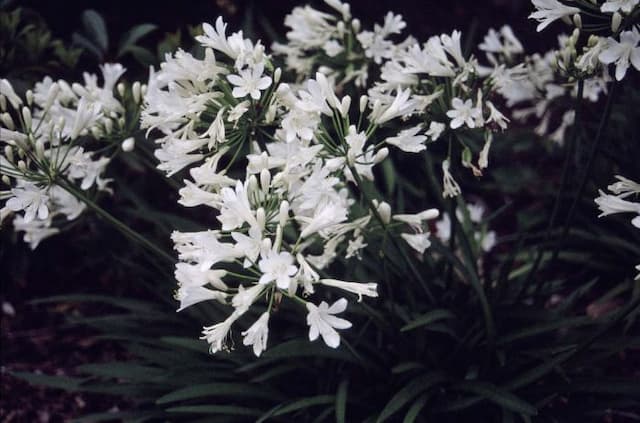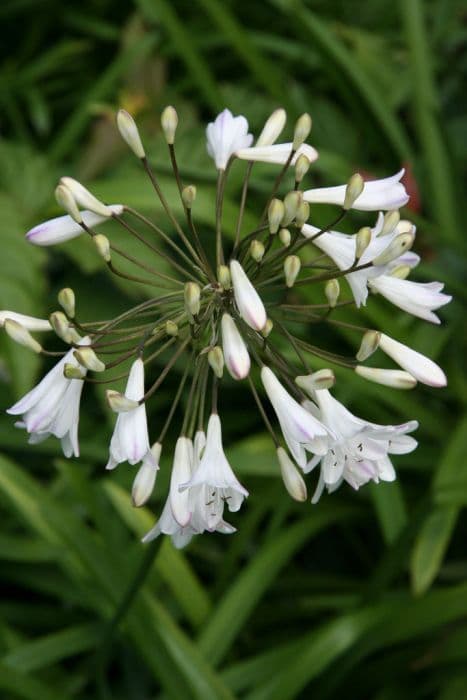African Lily Agapanthus 'Angela'

ABOUT
Agapanthus 'Angela' is a striking perennial plant, popular for its showy floral display and lush foliage. It features a dense clump of strap-like, glossy green leaves that gracefully arch outward, creating a lush mound of foliage. The leaves offer a nice contrast to the dramatic flowers. The most captivating part of this plant is its spherical clusters of funnel-shaped flowers, which sit atop long, slender stalks that rise above the foliage. These flowers are typically a deep blue or violet shade, sometimes with a hint of white, and are known for their long blooming period in the summer months. The floral globes, or umbels, are made up of dozens of individual star-like blooms, giving the impression of a fireworks display. The blossoms are particularly attractive to pollinators like bees and butterflies, adding movement and interest to the garden. When not in bloom, the plant retains its appeal with its verdant leaves, creating an elegant and tropical appearance throughout the growing season. Agapanthus 'Angela' is recognized for its neat, tidy form and is often used in garden beds, borders, and as a focal point in ornamental gardens, where its burst of blue can really stand out against other greenery. This plant can also be grown in containers, where its cascading foliage and stately flowers add height and structure to patio displays. Overall, it is the combination of its spectacular flower heads and rich green leaves that make Agapanthus 'Angela' a beloved choice among gardeners.
About this plant
 Names
NamesFamily
Amaryllidaceae
Synonyms
African Lily, Lily of the Nile, Love Flower
Common names
Agapanthus 'Angela'.
 Toxicity
ToxicityTo humans
Agapanthus, also known as Lily of the Nile, contains components that can be toxic to humans if ingested. The plant's sap, in particular, may cause skin irritation or allergic reactions in sensitive individuals. If someone eats any part of the plant, they may experience symptoms such as nausea, vomiting, abdominal pain, and diarrhea. In severe cases, ingesting large quantities of Agapanthus could lead to more serious consequences such as tremors or cardiac arrhythmia, although such extreme reactions are rare.
To pets
Agapanthus, commonly referred to as Lily of the Nile, is toxic to pets, including cats and dogs. If a pet ingests any part of this plant, they may exhibit symptoms such as vomiting, diarrhea, drooling, lethargy, or abdominal pain. There can also be more severe symptoms like difficulty breathing or an abnormal heart rate if a significant amount is consumed. Pet owners should be cautious and ensure that their pets do not have access to Agapanthus to prevent potential poisoning.
 Characteristics
CharacteristicsLife cycle
Perennials
Foliage type
Evergreen
Color of leaves
Green
Flower color
Blue
Height
3 feet [91 cm]
Spread
2 feet [61 cm]
Plant type
Herb
Hardiness zones
8
Native area
South Africa
Benefits
 General Benefits
General Benefits- Ornamental Value: Adds aesthetic appeal to gardens with its attractive blue or white flower clusters.
- Low Maintenance: Requires little care once established, making it ideal for gardeners of all skill levels.
- Drought Tolerant: Can survive with minimal watering, which is beneficial in areas with water restrictions or drought conditions.
- Long Blooming Season: Provides a lengthy display of flowers, often from late spring to late summer.
- Attracts Pollinators: The flowers are attractive to bees and butterflies, supporting local ecosystems.
- Deer and Rabbit Resistant: Typically not favored by deer or rabbits, which helps it to thrive in areas with wildlife.
- Coastal Conditions Tolerance: Capable of withstanding salt spray and winds, suitable for coastal gardens.
- Container Gardening: Suitable for pots, allowing it to be featured on patios, balconies, or small spaces.
- Soil Versatility: Adapts well to a variety of soil conditions, including clay, sandy, or loamy soils.
- Cutting Garden Plant: Flowers are excellent for cutting and creating floral arrangements.
 Medical Properties
Medical PropertiesThis plant is not used for medical purposes.
 Air-purifying Qualities
Air-purifying QualitiesThis plant is not specifically known for air purifying qualities.
 Other Uses
Other Uses- Photography Subject: Agapanthus, with its striking blue flowers, can be a beautiful subject for photographers, especially for macro photography, capturing the intricate details of the blooms.
- Artistic Inspiration: Artists can draw inspiration from the structure and color of Agapanthus for paintings, drawings, and even sculpture work.
- Dye Source: The blue flowers of the Agapanthus may be used to create natural dyes for textiles, providing a soft blue hue to fabrics.
- Educational Tool: In schools, Agapanthus can be used to teach students about plant biology and the life cycle of perennials.
- Culinary Decoration: The non-toxic flowers of Agapanthus can serve as an elegant garnish for high-end culinary dishes, adding a splash of color.
- Fairy Gardens: Miniature versions of Agapanthus can be perfect for creating fairy gardens, providing a whimsical landscape for imagination.
- Erosion Control: Agapanthus can be used in garden landscapes to help prevent soil erosion with its thick roots that stabilize the ground.
- Water Feature Complement: The plant's striking forms make it an excellent addition around ponds and water features in gardens.
- Symbolic Gift: Since Agapanthus symbolizes love letters, it could be offered as part of a bouquet or gift to convey a message of affection and admiration.
- Photographic Backdrop: Larger clumps of Agapanthus can be used as a natural backdrop for portrait photography, adding depth and interest to the images.
Interesting Facts
 Feng Shui
Feng ShuiThe Lily of the Nile is not used in Feng Shui practice.
 Zodiac Sign Compitability
Zodiac Sign CompitabilityThe Lily of the Nile is not used in astrology practice.
 Plant Symbolism
Plant Symbolism- Love Letters: The name "Agapanthus" is derived from the Greek words 'agape' meaning love, and 'anthos' meaning flower. Together, they symbolize love letters or a message of love.
- Beauty: The striking blue or purple flowers of the African Lily are associated with beauty and elegance, representing a person's appreciation for natural aesthetics.
- Fertility: In some cultures, the lush, abundant blooms of the African Lily are seen as a symbol of fertility and creation.
- Endurance: African Lily can tolerate a wide range of conditions, which makes it a symbol of endurance and adaptability.
- Protection: In some parts of the world, Agapanthus is believed to ward off evil spirits and is planted for its protective qualities.
 Water
WaterThe African Lily should be watered thoroughly, ensuring the soil is moist but not waterlogged. During active growth in spring and summer, water generously once a week with about half a gallon for an outdoor plant, depending on the size and weather conditions. Cut back to watering every two to three weeks during the fall and winter when the plant is dormant, providing only enough water to prevent the soil from completely drying out. Ensure proper drainage to avoid root rot.
 Light
LightThe African Lily thrives best in full sun to partial shade. It should be planted or placed in a location where it receives at least six hours of sunlight daily. However, in hotter climates, some afternoon shade can be beneficial to prevent scorching of the leaves.
 Temperature
TemperatureThe African Lily can survive in temperatures ranging from around 30 to 100 degrees Fahrenheit. It prefers to grow in temperatures between 60 and 75 degrees Fahrenheit. During winter, it's important to protect the plant from frost, which can damage or kill it.
 Pruning
PruningPrune the African Lily to remove spent flower stems and tidy up any dead leaves. This helps encourage new growth and more blooms. Pruning is best done after flowering, usually in the late summer or fall. It's not necessary to prune the plant often; once a year is sufficient.
 Cleaning
CleaningAs needed
 Soil
SoilThe African lily 'Angela' thrives best in a soil mix that is rich, loamy, and well-draining, with a slight preference for acidic to neutral pH levels between 6.0 and 7.0. A mix of two parts garden soil, one part peat moss, and one part perlite or sand is ideal to ensure proper drainage and root aeration.
 Repotting
RepottingThe African lily 'Angela' should be repotted every 2 to 3 years, or when it becomes root-bound. The best time to repot is in the spring before the new growing season begins.
 Humidity & Misting
Humidity & MistingThe African lily 'Angela' prefers moderate to high humidity levels but is quite adaptable and can tolerate less humid conditions common in most homes.
 Suitable locations
Suitable locationsIndoor
Place in bright, indirect light and keep soil moist.
Outdoor
Choose sunny spot, protect from harsh frost.
Hardiness zone
8-11 USDA
 Life cycle
Life cycleThe Agapanthus 'Angela', commonly known as African Lily, begins its life cycle when seeds are sown or rhizomes are divided and planted. Germination leads to the development of a small rosette of strap-shaped, green leaves. As the African Lily matures, these leaves elongate and the plant forms a robust clump. The plant then sends up tall flower stalks topped with spherical clusters of blue or purple funnel-shaped flowers, usually in summer. After blooming, seed pods may develop, which eventually dry and split open to release seeds for propagation. Once established, the plant enters a period of dormancy in colder months, retreating back to the rhizome, and then recommences its growth cycle in the following spring.
 Propogation
PropogationPropogation time
Spring to Summer
Agapanthus 'Angela', commonly known as the African Lily, is best propagated by division, a method that is both popular for its simplicity and effectiveness. The optimal time for dividing African Lilies is in the late spring or early fall when the plant is not in active bloom. To propagate by division, carefully dig up the clump of Agapanthus and gently separate the rhizomes, ensuring that each division has at least one to two healthy shoots and a portion of the root system. These divisions should then be immediately replanted at the same depth they were growing at originally, spaced about 12 to 18 inches (approximately 30 to 45 centimeters) apart to allow for ample growth. Water the new divisions thoroughly and maintain consistent moisture without overwatering, as African Lilies prefer well-drained soil. With proper care, these new plants will establish themselves and can produce blooms in the following seasons.


![African lily [Blue Storm]](/_next/image?url=https%3A%2F%2Fplants-admin.emdemapps.com%2Fimages%2Fplants%2F%2Fimages%2F604b63200a08b.png&w=640&q=75)






